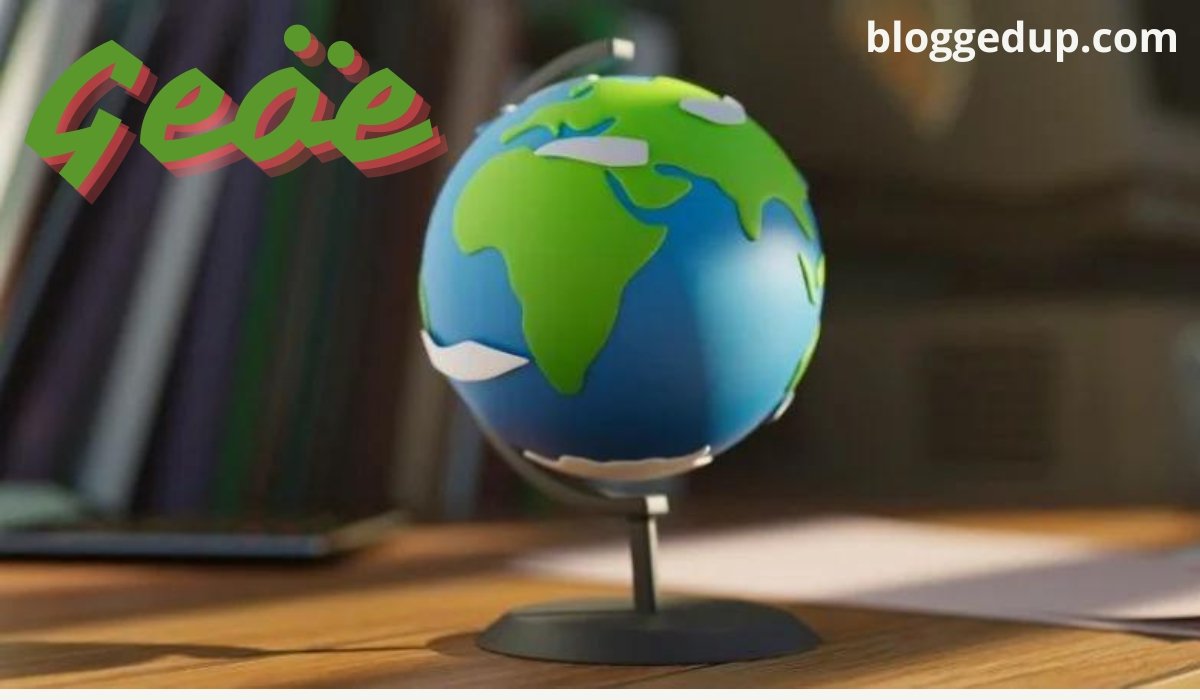Introduction Geöe
In our rapidly urbanizing world, balancing development with environmental sustainability is more challenging than ever. Geospatial technology (GEOE) plays a pivotal role in addressing these complex challenges, offering innovative solutions in urban development, environmental conservation, and beyond. This article dives deep into the multifaceted applications of geospatial technology, highlighting its crucial role in shaping our future cities and protecting our planet.
Understanding Geospatial Technology
Geospatial technology refers to the tools and techniques used to capture, store, analyze, and present spatial or geographic data. Key components include satellite imagery, Geographic Information Systems (GIS), Global Positioning System (GPS), remote sensing, and spatial analysis software. These components work together to provide detailed insights into various geographic phenomena, enabling informed decision-making across different industries.
Applications Across Various Industries
Urban Planning
Urban planners use GEOE to optimize city layouts by analyzing geographic data. GIS creates comprehensive maps that display land use patterns, infrastructure, and environmental features. This helps planners design efficient, sustainable cities that cater to residents’ needs while minimizing environmental impact.
Agriculture
In agriculture, GEOE monitors crop health and improves resource allocation. Remote sensing tools capture images of fields, identifying areas needing attention. Farmers can use this data to make informed decisions, optimizing crop yields and promoting sustainable farming practices.
Environmental Management
Environmental managers rely on GEOE to monitor and manage natural resources. Satellite imagery and GIS track deforestation, biodiversity loss, and illegal activities like poaching. This data supports conservation efforts, ensuring the protection of our planet’s vital ecosystems.
Transportation
Geospatial technology enhances transportation logistics and navigation. GPS and location-based services provide precise positioning, helping optimize routes and reduce travel time. Real-time traffic monitoring systems use GIS to manage congestion, improving overall transportation efficiency.
Telecommunications
Telecommunication companies use GEOE for network planning and optimization. GIS maps identify areas needing infrastructure improvements, ensuring better connectivity and service quality for customers.
Disaster Response
Geospatial technology is invaluable in disaster preparedness and recovery. Remote sensing and GIS provide real-time data on natural disasters, enabling efficient resource allocation and response efforts. This technology helps save lives and minimize damage during emergencies.
Innovative Spatial Solutions
Remote Sensing and Earth Observation
Remote sensing involves collecting data from satellites or aircraft to monitor environmental changes and assess natural disasters. This technology provides valuable insights into climate patterns, land use changes, and natural hazards, supporting effective environmental management and disaster response.
Geographic Information Systems (GIS)
GIS creates comprehensive maps and visualizations for various applications, from urban planning to natural resource management. By integrating multiple data sources, GIS provides a holistic view of geographic phenomena, facilitating informed decision-making.
Global Positioning System (GPS) and Location-Based Services (LBS)
GPS and LBS offer precise positioning and navigation, essential for various industries. From guiding drivers on the best routes to helping farmers manage their fields, these technologies enhance efficiency and productivity.
Spatial Data Analytics and Visualization
Spatial data analytics involves analyzing geographic data to uncover patterns and trends. This information helps businesses and governments make better decisions, improving operations and outcomes. Visualization tools transform complex data into easy-to-understand maps and charts, making insights more accessible.
Impact on Urban Planning and Development
Smart Cities
Geospatial technology is integral to developing smart cities, which use interconnected systems and data-driven decision-making to enhance urban efficiency. GIS and remote sensing provide the data needed to manage resources, monitor infrastructure, and improve residents’ quality of life.
Infrastructure Development and Management
GEOE supports land suitability assessments and infrastructure planning. By analyzing geographic data, planners can identify the best locations for new developments, ensuring they are safe, sustainable, and cost-effective.
Disaster Management and Risk Assessment
In disaster management, geospatial technology enables real-time monitoring and resource allocation. By providing accurate data on natural hazards, GEOE helps authorities prepare for and respond to disasters, minimizing their impact on communities.
Environmental Conservation and Management
Monitoring and Protecting Natural Resources
Geospatial technology is crucial for tracking deforestation, biodiversity loss, and illegal activities. Satellite imagery and GIS provide detailed data on environmental changes, supporting conservation initiatives and ensuring the protection of vital ecosystems.
Biodiversity Conservation
GIS-based mapping and ecological modeling support biodiversity conservation efforts. By identifying critical habitats and monitoring species populations, geospatial technology helps protect endangered species and maintain biodiversity.
Climate Change Mitigation
GEOE plays a vital role in monitoring greenhouse gas emissions and assessing climate impact. Remote sensing and GIS provide data on carbon dioxide levels, deforestation, and other factors contributing to climate change, informing mitigation strategies.
Precision Agriculture
Optimizing Crop Management
Geospatial technology helps farmers optimize crop management through GPS-guided equipment and sensors. This data-driven approach ensures precise planting, irrigation, and fertilization, improving crop yields and reducing waste.
Resource Allocation and Efficiency
GIS tools enhance resource allocation in agriculture, ensuring efficient use of water, fertilizers, and pesticides. By analyzing geographic data, farmers can identify areas needing attention and allocate resources accordingly.
Sustainable Farming Practices
Geospatial technology promotes environmentally friendly farming practices. Remote sensing and GIS support sustainable practices like crop rotation, cover cropping, and reduced tillage, helping protect soil health and reduce environmental impact.
Transportation and Logistics
Route Optimization
Geospatial technology enhances transportation routes for efficiency and safety. GPS and GIS analyze traffic patterns, road conditions, and other factors, ensuring optimal routes and reducing travel time.
Fleet Management
Real-time monitoring of vehicle location and performance is made possible through geospatial technology. Fleet managers can track their vehicles, ensuring efficient operations and reducing maintenance costs.
Real-Time Traffic Monitoring
Geospatial technology provides real-time traffic information, helping manage congestion and improve transportation efficiency. By analyzing traffic data, authorities can implement measures to reduce delays and enhance road safety.
Challenges and Future Directions
Data Privacy and Security
Despite its many benefits, geospatial technology raises concerns about data privacy, security, and ethical use. Ensuring the responsible use of geographic data is crucial to protect individuals’ privacy and maintain public trust.
Integration and Interoperability
Integrating geospatial technology with existing systems and ensuring interoperability can be challenging. Developing standards and protocols to facilitate seamless data exchange is essential for maximizing GEOE’s potential.
Advancements in AI and Machine Learning
The future of geospatial technology lies in advancements in AI and machine learning. These technologies can enhance GEOE’s capabilities, enabling more accurate predictions, automated analyses, and innovative solutions to complex challenges.
Conclusion
Geospatial technology is revolutionizing urban planning, environmental management, and various other industries. By providing detailed insights into geographic phenomena, GEOE supports informed decision-making, enhances efficiency, and promotes sustainability. Urban planners, environmentalists, and tech innovators must embrace geospatial technology to address the challenges of our rapidly changing world.
Frequently Asked Questions (FAQs)
1. What is geospatial technology?
Geospatial technology encompasses tools, like GIS and remote sensing, used to collect, analyze, and visualize geographic data for various applications.
2. How does geospatial technology benefit urban planning?
It aids in smart city development, infrastructure management, and disaster response by providing detailed geographic data for informed decision-making.
3. What role does geospatial technology play in environmental conservation?
Geospatial technology monitors natural resources, tracks biodiversity, and assesses climate impacts, supporting conservation efforts and sustainable practices.
4. How is geospatial technology used in agriculture?
It optimizes crop management and resource allocation through precision farming techniques, enhancing yields while promoting sustainable farming practices.
5. What are the challenges associated with geospatial technology?
Challenges include data privacy concerns, integration with existing systems, and the need for advancements in AI and machine learning to enhance GEOE capabilities.









